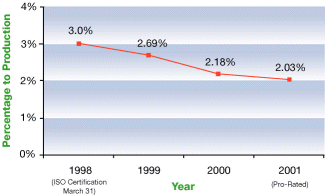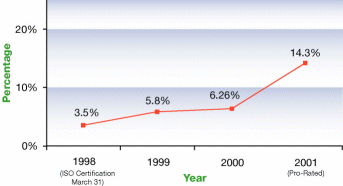Using Measurements to Improve Quality
Quality is likely to be a company slogan rather than a guarantee. If the 20th century is remembered as the century of great production, the 21st will come to be known as the century of raising the bar on quality.
Executive training programs are becoming the procedure that will set the standard for measuring the competitiveness of companies. In short, quality improvements are the way to survival and profits. Quality means survival. It means more than just better products - it also means less waste, greater efficiency, better incomes, lower costs, more profits and more satisfied customers.
The cost of poor quality will become part of the balanced scorecard used by financial analysts, credit rating firms and companies considering a company's potential as a business acquisition. It can be seen as part of a long evolution. First came the Industrial Revolution, featuring both high quality and high costs. Then came mass production, with moderate quality and lower costs. Today, we are in a third era of rising quality and falling costs. This is accomplished by pushing quality goals deep into the process of obtaining raw materials, up through production and processes and on through the uses of today's vast information resources.
Times have changed. Far more so than ever, quality is essential to a company's health and survival - not just a claim or a boast, but a scorecard to be used by customers, suppliers, investors and others.
Toolmakers must seek constant improvement, and should invest in people as well as machines. The moldmaking industry is at a crossroads. It is ironic that the results of a moldmaker's labor are sturdy enough to run millions of parts before needing overhaul, but the industry itself is fragile - indicating that the next downturn in the market could force a significant number of moldmakers out of business. This downsizing will occur as a result of the way that the industry manages challenges and the operational methods employed to address customer needs.
When a customer steps up its requirements of moldmakers, the common answer for many shops is to look at computers and machinery. When customers look for increased efficiencies, many in the moldmaking industry have a tendency to say, "We're doing the best we can - we've already made improvements," or "We know what we are doing; we've been doing this for years." As a result, they take a problem and compound it in their minds. The operating methods of the past must be renewed into a new program of continuous improvement for the future. Customers desire lower costs and higher quality with profitability. Similarly, moldmakers are in business to be profitable, and you owe it to yourselves as responsible business owners to manage your business accordingly.
ISO 9001:2000 requires an organization to examine and measure performance of processes, customer satisfaction and product conformity. There are a variety of tools available to companies to accomplish this examination and measurement, but when it comes to examining the performance of people and teams, the tools become very limited.
However, it is not enough to just receive a certificate showing "We are ISO registered." OEMs and their industry supply chain are looking for ways to reduce waste, and responsible businesses must fine a way - either internally or through consultants - to nurture extraordinary team, company and individual performance.
ISO 9001 - What Has It Done for AEI?
According to Allen Dekmar, a quality assurance manager for American Eagle Instruments, Inc. (AEI) (Missoula, MT), "Probably the first question a business might ask when considering ISO implementation would be: 'Is the expense and time to ISO certification really worth the trouble?' As ISO coordinator and quality assurance manager for American Eagle Instruments, Inc., my answer would be an unequivocal 'yes!'"
AEI manufactures a line of dental products that are marketed worldwide. From the ashes of a buyout and plant closure more than nine years ago, laid off workers formed the employee-owned company, which has since risen to the number two player in the industry - behind only the company that they had formerly worked for. Today, AEI boasts a flourishing business and a new facility designed with input from production employees.
From the outset of the business plan, AEI's philosophy has been to build the highest quality dental instruments on the market and maintain that ideal, which still continues to be the mainstay of the company.
Five years ago, AEI began looking at ISO certification as an investment to help maintain its quality philosophy - for its international marketing appeal and to use as an organizational pattern for its manufacturing processes. As a charter employee who not only was familiar with all applicable manufacturing processes, but also was a former journeyman instrument maker, Dekmar was given the project to bring AEI into ISO certification.
The new ISO 9001:2000 standard puts an unprecedented emphasis on measurement. Although companies may find compliance challenging, they will benefit from an improved quality system.
American Eagle Instruments satisfies ISO 9001, FDA and CE Mark requirements. These requirements established standards for acceptable measurement levels for the majority of all quality system processes, which have been published for productivity and quality levels.
Benchmarking is an excellent way to not only establish measurements for excellence, but also to learn new process improvement techniques, starting with tool design and development and progressing to manufacturing and total customer satisfaction. ISO 9001:2000 puts the requirement on each manufacturer to define its internal processes and to develop measurements that ensure that these processes are effective. While adjusting to the new standard will be challenging for many tool makers and manufacturers, the end result will pay them back many times over.
After a little more than eight months, certification to ISO 9001 and CE marking became reality for AEI. Upon certification, the company's outlook on ISO 9001 was that it would use it as a tool as efficiently as possible to recoup its investment and to optimize associated benefits.
Did it work? You bet it did. Initially, ISO 9001 gave AEI the obvious "stamp of approval" in the worldwide sales market and made it a viable and serious market player, but the real benefits of ISO were made inside the manufacturing facility. In short, ISO "solidified" AEI's manufacturing processes by mandating the company to evaluate and improve its process systems. Enticed by the economic benefits of "continuous quality improvements," AEI took a "micro-look" at all of its systems and processes, and asked, "why do we do what we do?" and "why do we use the materials and systems the way we do?" As a result, production costs were lowered throughout the facility, systems and man-hour efficiencies were greatly improved, the products maintained "continuous quality improvements," customer satisfaction went up and rework and rejects went down (see Figure 1 and Figure 2).
The systems and facility took on a clean and orderly look - one that "felt" more functional, streamlined and labeled - all of which added to a feeling of professionalism to both process and administration employees.
On supply chain economics, attitudes towards and expectations from suppliers were dramatically changed. Using ISO 9001 as a tool, AEI was able to add - simply from savings gained from suppliers - 3.5 percent to pre-tax earnings during the initial year of ISO certification, 5.8 percent the second year, 6.26 percent the third year and 14.3 percent projected for the current year (see Figure 3). The first raw material suppliers contacted after certification reduced cost 10 percent, which recouped a large part of AEI's certification costs.
Exactly how much influence did ISO have on American Eagle Instruments is difficult to measure precisely. What ISO 9001 did do is make the company take organized control of its manufacturing processes and the resultant associated systems improvements. The economic benefits have definitely made an impact on AEI's bottom line, which, as the company continues to grow and prosper, makes employee investors happy.
Conclusion
So, in today's marketplace, it is imperative that manufacturers be responsive, efficient, price competitive, quality minded and customer oriented. They can only effectively perform all of the activities required to meet these business criteria via the utilization of a reliable, well-trained and professional workforce. Leadership through communication via ISO 9001 certification is key.
Related Content
Mold Design Review: The Complete Checklist
Gerardo (Jerry) Miranda III, former global tooling manager for Oakley sunglasses, reshares his complete mold design checklist, an essential part of the product time and cost-to-market process.
Read MoreThink Safety: Eliminate Hazards Throughout the Shop
The tooling community is taking advantage of new products for safer mold shops and molding facilities.
Read MoreThe Critical Role of Management Representatives in ISO 9001
In ISO 9001 quality management systems, the Management Representative (MR) plays a crucial role. While the 2015 version of ISO 9001 no longer mandates this position, having a trusted management member serve as an MR remains vital for streamlining operations and maintaining quality standards.
Read MoreTackling a Mold Designer Shortage
Survey findings reveal a shortage of skilled mold designers and engineers in the moldmaking community, calling for intervention through educational programs and exploration of training alternatives while seeking input from those who have addressed the issue successfully.
Read MoreRead Next
How to Use Strategic Planning Tools, Data to Manage the Human Side of Business
Q&A with Marion Wells, MMT EAB member and founder of Human Asset Management.
Read MoreReasons to Use Fiber Lasers for Mold Cleaning
Fiber lasers offer a simplicity, speed, control and portability, minimizing mold cleaning risks.
Read MoreAre You a Moldmaker Considering 3D Printing? Consider the 3D Printing Workshop at NPE2024
Presentations will cover 3D printing for mold tooling, material innovation, product development, bridge production and full-scale, high-volume additive manufacturing.
Read More






















